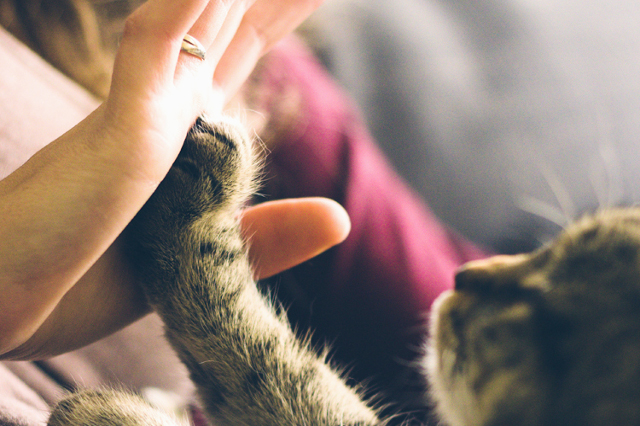Cat nail trimming is something we’re very frequently asked about at our clinic, and for good reason! Cat’s nails are retractable, meaning they’re kept hidden until the cat needs to use them. These nails can grow back fast sometimes! Almost every cat needs to have their nails trimmed regularly; others, not so much for a few reasons.
Regardless, it’s a good idea to prepare your cat for nail trimming by using certain strategies in your cat’s regular grooming routine. For you, the cat parent, you will need to learn how to trim their nails safely. Here is what you need to know.
Why Do Some Cats Not Need to Have Their Nails Trimmed?
Trimming or not is generally dependent on your cat’s lifestyle.
Outdoor Cats – If your cat is an outdoor cat, it may be a bad idea to trim his or her nails because they are needed for important tasks:
- Climbing – Cats need to climb to navigate their territory and also to escape danger when pursued by other animals.
- Scratching – Cats nails are always growing, and scratching is an instinctive act that keeps the nails trim and sharp.
- Marking Territory – Cats have scent glands in their paws, and will scratch as well as urinate to help them mark their territory outdoors and keep other strange animals away.
Indoor Cats – If your cat is an indoor cat, you may need to trim your cat’s nails more frequently:
- If your cat has a scratching post and likes to use it, his or her nails may need only occasional trimming when young, especially if his or her nails grow very slowly.
- If you regularly take your indoor cat outside for walks on a leash, he or she may have opportunities to scratch and wear down his or her nails and reduce the amount of trimming needed.
Why Do Almost All Cats Need to Have Their Nails Trimmed?
- An indoor cat may not be very interested in using a scratching post and so their nails may grow too fast and too long to be curbed by the post.
- As an outdoor cat ages, he or she may become so much less active that the nails grow out. This increases the risk of their nails growing into a curve that drives into their footpads, and in turn causes your cat pain, mobility problems, or even infections.
- Both indoor and outdoor cats need to have their nails trimmed because their nails can be snagged and caught in soft surfaces, or the cat may lose their ability to retract their claws altogether.
- Arthritic cats, indoors or out, usually don’t exercise enough to keep their nails short via scratching.
How Often Should My Cat’s Nails be Trimmed?
- For indoor cats, nail trimming in general should be done every ten days to two weeks.
- A senior indoor or outdoor cat will often develop thick, brittle nails that need to be trimmed more often than when they’re a kitten. Stay alert.
- Declawing cats was made illegal in BC in 2018 by the B.C. College of Veterinarians. It is now understood that declawing means that the ends of the toes are amputated during the surgery, which has been stated as “ethically problematic and not an appropriate means of dealing with feline behaviour issues”. So now if you live in BC you must learn to trim your kitty’s nails properly, or either pay a groomer or visit your cat’s veterinarian to perform this task.
- An outdoor cat may become more of an indoor cat when he or she is old and arthritic, so regular nail trimming will become a necessity.
- Usually it is only the front paws nails that need to be trimmed, but if you notice that the back paw nails are digging into you when your cat jumps up into your lap, you should trim those nails as well.
Here is the Nail Trimming Process
- First Things First
- Most cats don’t like to have their nails trimmed and some will absolutely not tolerate it. If your cat won’t even allow you to hold his or her paws, you may have to rely on a pet groomer or your cat’s vet to trim your pet’s nails.
- If you take a slow and easy approach, you can succeed in time, especially if you have treats ready, and your cat may associate the nail clipping routine with yummy treats.
- Don’t attempt to clip your cat’s nails if your pet is upset or if you are upset.
- Organize Your Supplies:
- Towel – You can gently wrap your cat loosely in a towel if you are afraid he or she might suddenly bolt off your lap and scratch you.
- Sharp cat nail clippers – There are a variety of good nail clippers for cats. Some of them are designed to make sure you don’t clip too close to the vein that runs into the thick part of the claw.
- Styptic Powder – If you have clippers that aren’t designed to protect the vein and you accidently cut into it, you can apply a small amount of powder to stop the bleeding.
- Rehearsals are Important
- Even an outdoor cat should become used to the idea that you can hold and massage his or her paws and extend the nails when your cat is seated on your lap. It’s easier for a young cat to become used to a routine rather than introduce it when your cat is older and it becomes a necessity.
- For several days prior to the first nail trimming, hold your cat in your lap facing away from any windows and away from you in a quiet room. Gently massage your cat’s neck and then the front legs and paws. Talk quietly to your little pet as you do this. Gently press on the footpad to extend a nail, then quickly release it, and give your cat a treat. Do this every day on a different toe. Note the pink part of the nail, called the quick—this is the extra sensitive part of their nail consisting of nerves and blood vessels.
- Do the Deed!
- When you and kitty are used to this routine, pick a time when your cat is sleepy and relaxed after eating, and prepare to clip only one or two nails—no more. Do everything the same as usual, only this time, cut the tip off one of the nails. If everything goes well, cut the tip off one more nail and give your kitty a treat.
- Proceed until you have clipped all of the front paw nails over a period of five days or so, and your cat will soon adjust, especially to the regular treats! You will then be able to trim all the nails on the front and back paws at one sitting.
Many cats don’t need their nails trimmed, but if yours does, learn how to do the job safely. If it will help, make massaging the toes and extending a nail part of their regular grooming and care. If you know you must trim your cat’s nails, rehearse with your pet until you are both comfortable before attempting the job. Expect to trim your cat’s nails every 10 days or so as part of your cat’s regular grooming routine. If all else fails, ask your cat’s groomer or your veterinarian to do the job for you.
Creative Commons Attribution: Permission is granted to repost this article in its entirety with credit to Hastings Veterinary Hospital and a clickable link back to this page.






